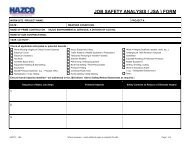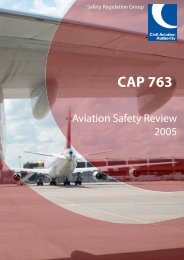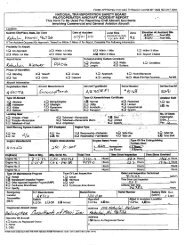International Helicopter Safety Team Safety Management System Toolkit
IHST - Safety Management Toolkit - Skybrary
IHST - Safety Management Toolkit - Skybrary
- No tags were found...
You also want an ePaper? Increase the reach of your titles
YUMPU automatically turns print PDFs into web optimized ePapers that Google loves.
ing of the accountability, responsibility and authority<br />
of all individuals involved in the system.<br />
<strong>Management</strong> should document and distribute the<br />
organization’s operations policy by promoting a<br />
common understanding of everyone’s role in the<br />
safety management system.<br />
<strong>Management</strong>’s responsibility and accountability<br />
for the SMS should be identified. Well-defined<br />
lines of authority should be clearly established.<br />
These requirements include:<br />
The accountable manager is responsible for<br />
establishing and maintaining the safety<br />
management system.<br />
The functional area of direct responsibility, (i.e.,<br />
maintenance or flight operations), is responsible<br />
for the safety program.<br />
Everyone is responsible for safety in the organization.<br />
This includes operations and maintenance<br />
personnel as well as individuals in other non-technical<br />
areas.<br />
The person responsible for the affected functional<br />
area, the manager of operations or maintenance,<br />
is accountable for determining and implementing<br />
appropriate comprehensive corrective actions.<br />
The reasons for establishing clearly defined<br />
lines of authority is three-fold:<br />
The manager is the person with direct line responsibility<br />
for the affected area and is directly involved in<br />
the decision-making process. In most cases, he/she<br />
has the knowledge and expertise to recommend<br />
effective actions and has the authority to assign the<br />
appropriate resources where required.<br />
The manager must assume responsibility for safety<br />
within his/her own area of responsibility. In this<br />
way, he/she is involved in the “safety process”<br />
and is accountable for issues that arise in his/her<br />
functional area.<br />
A quality assurance function is provided<br />
because occurrence investigations and corrective<br />
actions are separate activities and responsibilities.<br />
This eliminates the potential conflict of<br />
interest because the person who identifies the<br />
problem is not the person who determines what<br />
corrective action to take. This does not preclude<br />
the safety committee from discussing safety findings<br />
and making recommendations. However,<br />
the final say on any remedial action resides with<br />
the responsible manager, depending on the size<br />
of the organization.<br />
20 SMS <strong>Toolkit</strong>







